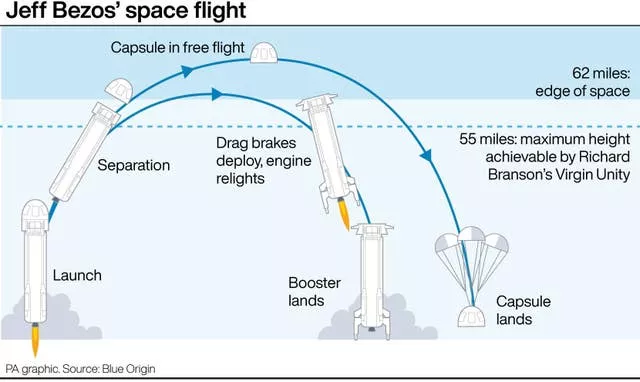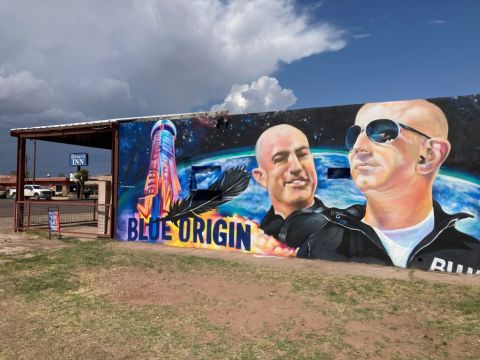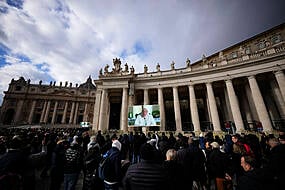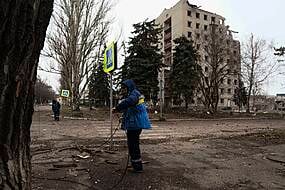Jeff Bezos, the world's richest man, and three crewmates have soared high above the Texas desert and returned to Earth, a historic suborbital flight that helps to inaugurate a new era of private commercial space tourism.
The billionaire strapped into his Blue Origin’s sub-orbital New Shepard rocket on Tuesday, the 52nd anniversary of the Apollo 11 moon landing.
Alongside him were his brother Mark, female astronaut Wally Funk who trained in 1961 but never went to space, as well as the company’s first customer, Dutch 18-year-old Oliver Daemen.
The spacecraft ignited its BE-3 engines for a liftoff from Blue Origin's Launch Site One facility about 20 miles (32 km) outside the rural town of Van Horn. There were generally clear skies with a few patchy clouds on a cool morning for the launch.
10 minute voyage
The 57-year-old American billionaire flew on a voyage lasting about 10 minutes and 20 seconds to the edge of space, nine days after Briton Richard Branson was aboard his competing space tourism company Virgin Galactic's successful inaugural suborbital flight from New Mexico.
The mission was part of a fiercely competitive battle between Mr Bezos' Blue Origin and fellow billionaire Mr Branson's Virgin Galactic to tap a potentially lucrative space tourism market the Swiss bank UBS estimates will be worth $3 billion annually in a decade.
Mr Bezos, wearing a blue flight suit and cowboy hat, and the other passengers climbed into an SUV vehicle for a short drive to the launch pad before walking up a tower and getting aboard the gleaming white spacecraft, with a blue feather design on its side. Each passenger rang a shiny bell before boarding the craft's capsule.

"They are in for the flight of a lifetime," launch presenter Ariane Cornell of Blue Origin said on a live webcast.
Mr Branson got to space first, but Mr Bezos was due to fly higher - 62 miles (100 km) for Blue Origin compared to 53 miles (86 km) for Virgin Galactic - in what experts call the world's first unpiloted space flight with an all-civilian crew. It represents Blue Origin's first crewed flight to space.
The flight coincides with the anniversary of Americans Neil Armstrong and Edwin "Buzz" Aldrin becoming the first humans to walk on the moon, on July 20th, 1969. New Shepard is named for Alan Shepard, who in 1961 became the first American in space.
Ms Funk was one of the so-called Mercury 13 group of women who trained to become NASA astronauts in the early 1960s but was passed over because of her gender. Mr Daemen, Blue Origin's first paying customer, is set to study physics and innovation management in the Netherlands. His father, who heads investment management firm Somerset Capital Partners, was on site to watch his son fly to space.
The launch was witnessed by members of the Bezos family and Blue Origin employees, and a few spectators gathered along the highway before dawn. Spectators applauded during the flight.
Minutes of weightlessness
New Shepard is a 60-foot-tall (18.3-meters-tall) and fully autonomous rocket-and-capsule combo that cannot be piloted from inside the spacecraft. It is completely computer-flown and had none of Blue Origin's staff astronauts or trained personnel onboard.
Virgin Galactic used a space plane with a pair of pilots onboard.
New Shepard was designed to hurtle at speeds upwards of 2,200 miles (3,540 km) per hour to an altitude of about 62 miles (100 km), the so-called Kármán line set by an international aeronautics body as defining the boundary between Earth's atmosphere and space.
Our astronauts have completed training and are a go for launch. #NSFirstHumanFlight pic.twitter.com/rzkQgqVaB6
— Blue Origin (@blueorigin) July 19, 2021
Advertisement
After the capsule separates from the booster, the crew was due to have unbuckled for a few minutes of weightlessness. Then the capsule was due to fall back to Earth under parachutes, using a last-minute retro-thrust system that expels a "pillow of air" for a soft landing in the Texas desert.
The reusable booster had previously flown twice to space.
The launch represented another step in the race to establish a space tourism sector that Swiss investment bank UBS estimates will reach $3 billion annually in a decade. Another billionaire tech mogul, Elon Musk, plans to send an all-civilian crew on a several-day orbital mission on his Crew Dragon capsule in September.
Blue Origin aims for the first of two more passenger flights this year to happen in September or October.







